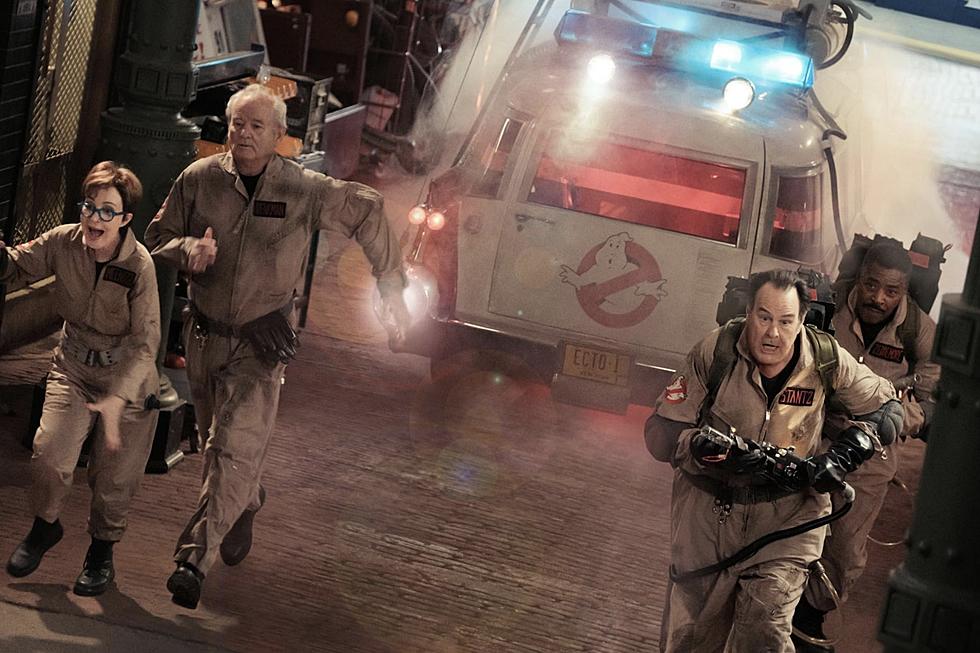
Let’s Explain Why Sequels (And Prequels and Reboots) Obsessed With Explaining Stuff Are Bad
The following post contains SPOILERS for Blair Witch, Jason Bourne, Spectre, Ghostbusters, and Star Wars: Episode I - The Phantom Menace. Oh my God, Phantom Menace spoilers! RUN FOR YOUR LIFE!
Has this ever happened to you? You’re sitting at home late at night, sipping brandy on a leopard-skin rug beside a roaring fire. In the quietude of the evening, you are alone. The lapping of the titian flames is the only soundtrack to your deepest thoughts. And in this moment of hushed contemplation, you wonder:
“Where the f--- did Minions come from?”
We’ve all been there. I personally spent most of the early 2010s on this enigma, until last summer’s Minions came along and explained it: The Minions are an immortal race of sentient Twinkies who’ve existed since the dawn of time serving despicable people. I always wondered how they met Gru, their evil master from the Despicable Me films, but Minions explained that too (in the midst of an elaborate heist involving the Crown Jewels). That’s it. Case closed. Put out the fire. Fold up the leopard-skin rug. Go to bed.
Minions is perhaps the least essential entry in a growing Hollywood subgenre: Sequels, prequels, and reboots that go overboard in explaining things about their predecessors nobody particularly cared about in the first place — or in some cases liked specifically because they were left unclear. Designed to appeal to a fandom obsessed with “solving” movies like they’re jigsaw puzzle, produced by an industry desperate to find any way to freshen up the same handful of well-worn properties, these overly expository pictures are sucking all of the mystery out of franchise filmmaking.
The most recent example is Blair Witch, the new sequel to the 1999 found-footage classic about a group of documentary filmmakers who vanish in the woods. Fans of the original Blair Witch Project treasure its atmosphere of uncertainty. Is there a witch? What is terrorizing these people? Was there really something supernatural in those woods? The new Blair Witch dispels almost of those questions, making it very obvious that otherworldly forces are at work by adding a time-travel element, several glimpses of a witch-like creature, and an explanation why one of the filmmakers in the first Blair Witch Project is seen standing in a corner just before the movie’s tragic ending. It turns out this witch creature can only kill you when you look at it, hence standing in the corner to avoid eye contact.
Never mind that the first Blair Witch already offered a possible reason for this strange behavior. (Rustin Parr, a local urban legend, supposedly made children stand in the corner while he executed his victims.) This new Blair Witch attempts to create an additional layer of mythology, connecting the old Rustin Parr legend with the Blair Witch. But trying to mythologize this material just demystifies it. There’s no curiosity about this creature, just disappointment that something that was previously so baffling is now so clear.
Blair Witch comes hot on the heels of a summer full of mythologizing and demystifying blockbusters. In Finding Dory, we learn the origins of the forgetful fish and her past with a family she doesn’t remember. Jason Bourne added a previously unknown (and currently unnecessary) wrinkle to the title hero’s origin involving his father and the program that turned him into a super-spy. The Legend of Tarzan explained the, uh, legend of Tarzan. Go back to 2015 and you find super-explainy movies like Minions, Pan, Paranormal Activity: The Ghost Dimension, and Spectre, which revealed the “shocking” “twist” that James Bond’s old arch-enemy Blofeld was not only behind the events of all three previous Daniel Craig Bond movies (even though that made no sense), he was also his brother! (Even though that also made no sense.) And even if it did make sense (and, to be clear, it didn’t), all of these was laid out in a dull and talky sequence where Christoph Waltz’s Blofeld talks Bond’s ear off before shoving a needle into it.
(WARNING: When viewing this scene from Spectre, marked drowsiness may occur. Avoid alcoholic drinks and be careful when operating heavy machinery for at least four hours after watching this clip.)
One of the most frustrating and striking examples of this trend was this summer reboot of Ghostbusters. In Ivan Reitman’s Ghostbusters from 1984, some fairly important information is totally elided. How did a bunch of Columbia University dorks design a gorgeous eye-catching logo? How do they build so much equipment so fast? How does it all work? Why are all these ghosts showing up now? Rather than dwell on these minute (and ultimately unimportant) details, Reitman cuts away from these boring parts to focus on the fun; the Ghostbusters cracking jokes and catching ghosts.
Paul Feig’s Ghostbusters attempts to provide explanations for all these things. Now the logo is created by a tagger in the New York subways, and later becomes an actual enemy the heroes have to fight. All of their equipment has to be tested before it can be put to use in the field. The film’s primary antagonist is using some gadget to break down the previously sturdy barrier between the worlds of the living and the dead, hence the sudden appearance of apparitions after thousands of years without concrete evidence of their existence.
These elements are uniformly the weakest parts of Feig’s movie. When he lets his amazing cast riff and catch ghosts like in the original Ghostbusters, it works. When he tries to justify all the stuff the first movie left unexplained, the new Busters begins to sag.
I recognize that the impulse to spell out these details comes from a logical place. When you’re making and remaking the same concepts over and over, you have to find new angles on old ideas. Amidst this glut of familiarity, how do you do something different? One of the easiest ways is to find something left unresolved in the last movie, deliberately or not, and clarify it. Very few of these sequels and reboots have any reason to exist beyond the desire to make a lot of money for their rights holders. A supposedly mind-blowing secret justifies their production.
These secrets also speak to many moviegoers, and particularly the kind of young, internet-savvy moviegoers who love to drill down into the details and look for dangling subplots they can spin out into theories they can then share and discuss on Reddit and social media. Fan speculation can help drive interest in potential sequels. But this sort of word-of-mouth hype is a double-edge sword — about which a studio executive somewhere surely just asked “Is there a way we could try to explain how the sword got two edges? I think audiences are going to wonder.”
When I discussed this problem on a recent episode of The /Filmcast, a listener named Drew Wallner tweeted to suggest a name for this subgenre: “Midi-chlorianated movies,” after the incredibly dumb revelation from Star Wars: Episode I - The Phantom Menace that microscopic organisms called “midi-chlorians” gave people access to the Force.
In the original Star Wars trilogy, the Force was a glorious mystery. The full scope of its power, its origin, and its usage was never revealed, and what little the movies did discuss typically came out of the mouth of Yoda who said everything backwards anyway. Fans spent decades spinning out their own theories about the Force, and all of that was wiped away by tiny little critters in Jake Lloyd’s magic blood. This isn’t the only basis for viewers’ disgust with the Star Wars prequels — but it’s certainly a key one.
The Phantom Menace might be the worst example of a midi-chlorianated movie, but it’s very hard to think of a movie that tried this strategy and succeeded. 300: Rise of the Empire? No. (Although Eva Green was fun.) Pan? LOL. Prometheus? Nope — and that film barely even explained the origins of the aliens from Alien amidst some very forgettable characters and some very questionable decisions.
But don’t worry, we have Alien: Covenant coming next year to erase any lingering vagueness about those damn face huggers. We’ll also discover Star-Lord’s confusing family history in Guardians of the Galaxy Vol. 2, and whether Deckard really was a replicant or not in the new Blade Runner. And we’ll finally learn about the Rebels who stole the Death Star plans from the original Star Wars in Rogue One. Haven’t you always wondered about the Rebels who stole the Death Star plans? Well too bad, that’s what the next Star Wars is about anyway.
In today’s studio system, no ambiguity is safe. Everything must be explained until nothing is left to the imagination — even when that room for imagination made the original films popular in the first place. It may not be a coincidence that many of the movies on this list were box-office disappointments, and potential franchise killers. The reasons why do not require an elaborate explanation. It’s enough to make my midi-chlorianated blood boil.
More From ScreenCrush









